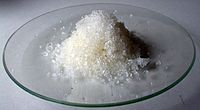Cadmium nitrate
 |
|
 |
|
| Names | |
|---|---|
|
IUPAC name
Cadmium(II) nitrate
|
|
| Other names
Nitric acid, cadmium salt
|
|
| Identifiers | |
|
10325-94-7 10022-68-1 (tetrahydrate) |
|
| 3D model (Jmol) | Interactive image |
| ChEBI |
CHEBI:77732 |
| ChemSpider |
23498 |
| ECHA InfoCard | 100.166.363 |
| EC Number | 233-710-6 |
| UNII |
VF9RQV8VXV |
| UN number | 3087 |
|
|
|
|
| Properties | |
| Cd(NO3)2 | |
| Molar mass | 236,42 |
| Appearance | White crystals, hygroscopic |
| Odor | Odorless |
| Density | 3.6 g/cm3 (anhydrous) 2.45 g/cm3 (tetrahdyrate) |
| Melting point | 360 °C (680 °F; 633 K) at 760 mmHg (anhydrous) 59.5 °C (139.1 °F; 332.6 K) at 760 mmHg (tetrahydrate) |
| Boiling point | 132 °C (270 °F; 405 K) at 760 mmHg (tetrahydrate) |
| 109.7 g/100 mL (0 °C) 126.6 g/100 mL (18 °C) 139.8 g/100 mL (30 °C) 320.9 g/100 mL (59.5 °C) |
|
| Solubility | Soluble in acids, ammonia, alcohols, ether, acetone |
| −5.51·10−5 cm3/mol (anhydrous) −1.4·10−4 cm3/mol (tetrahydrate) |
|
| Structure | |
|
Cubic (anhydrous) Orthorhombic (tetrahydrate) |
|
| Fdd2, No. 43 (tetrahydrate) | |
| mm2 (tetrahydrate) | |
|
α = 90°, β = 90°, γ = 90°
|
|
| Hazards | |
| GHS pictograms |
  
|
| GHS signal word | Danger |
| H301, H330, H340, H350, H360, H372, H410 | |
| P201, P260, P273, P284, P301+310, P310 | |
|
EU classification (DSD)
|
|
| R-phrases | R25, R26, R45, R46,R48/23/25, R50/53, R60, R61 |
| S-phrases | S28, S36/37, S45, S53, S60, S61 |
| NFPA 704 | |
| Lethal dose or concentration (LD, LC): | |
|
LD50 (median dose)
|
300 mg/kg (rats, oral) |
| US health exposure limits (NIOSH): | |
|
PEL (Permissible)
|
[1910.1027] TWA 0.005 mg/m3 (as Cd) |
|
REL (Recommended)
|
Ca |
|
IDLH (Immediate danger)
|
Ca [9 mg/m3 (as Cd)] |
| Related compounds | |
|
Other anions
|
Cadmium acetate Cadmium chloride Cadmium sulfate |
|
Other cations
|
Zinc nitrate Calcium nitrate Magnesium nitrate |
|
Except where otherwise noted, data are given for materials in their standard state (at 25 °C [77 °F], 100 kPa).
|
|
|
|
|
| Infobox references | |
Cadmium nitrate describes any of the related members of a family of inorganic compound with the general formula Cd(NO3)2.xH2O. The anhydrous form is volatile but the others are salts. All are colourless crystalline solids that absorb moisture from air and becomes watery, that is deliquescent. Cadmium compounds are also known to be carcinogenic.
Cadmium nitrate is used for coloring glass and porcelain and as a flash powder in photography.
Cadmium nitrate is prepared by dissolving cadmium metal or its oxide, hydroxide, or carbonate, in nitric acid followed by crystallization:
Thermal dissociation at elevated temperatures produces cadmium oxide and oxides of nitrogen. When hydrogen sulfide is passed through an acidified solution of cadmium nitrate, yellow cadmium sulfide is formed. A red modification of the sulfide is formed under boiling conditions.
When with caustic soda solution, cadmium oxide forms precipitate of cadmium hydroxide. Many insoluble cadmium salts are obtained by such precipitation reactions.
...
Wikipedia

